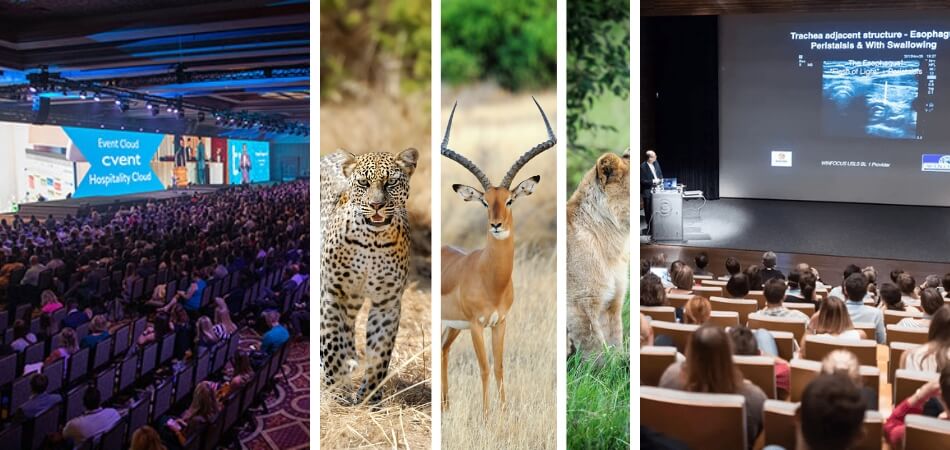Attending conferences is a valuable experience for professionals, offering opportunities for networking, learning, and growth. If you’ve ever wondered, “How much does it cost to attend the animal science and veterinary medicine conference?”, you’re not alone.
Navigating the costs associated with these events can be challenging, given the myriad of factors involved. On average, early bird registration may set you back between $400 and $500, while regular and late registrations can range from $400 to $1,000.
Yet, this is just the tip of the iceberg. Add in potential costs for workshops, special sessions, travel, accommodation, and meals, and the expense increases. Dive into our blog as we break down these figures and offer insights into managing and planning for such events effectively.
A Brief Overview of an Animal Science Conference
Animal science conferences are pivotal for professionals in the field. They offer vast learning opportunities and insights into current research. Engaging sessions and peer interactions are highlights.
These events bring together experts, researchers, and students. Varied topics encompassing livestock, genetics, and nutrition are discussed. Workshops provide hands-on experiences and enriching knowledge.
Besides academic pursuits, networking is a major draw. Establishing connections can lead to collaborations and job opportunities. The impact of these conferences transcends beyond mere learning.
Types of Animal Science Conferences
Animal science encompasses a broad range of study areas. Consequently, the conferences in this field are equally diverse, reflecting its multi-faceted nature. Each type has a unique focus and audience.
Livestock and Poultry Conferences
Focusing on domesticated creatures, these conferences dissect advancements in breeding, health, and production. They attract farmers, researchers, and agribusiness professionals. Innovative practices are frequently unveiled here.
Wildlife and Conservation Conferences
These events emphasize wild fauna studies and their conservation. Ecologists, researchers, and conservationists gather to discuss threats, solutions, and habitat management. Collaborative projects often initiate from these meetings.
Equine Science Conferences
Centered on horse biology, behavior, and health, these forums are pivotal for equine enthusiasts. Veterinarians, trainers, and breeders attend to learn and exchange experiences. Modern care practices dominate discussions.
Animal Genetics and Biotechnology Conferences
Exploring the DNA realm, these events present breakthroughs in animal genetics. Scientists, geneticists, and biotechnologists discuss gene editing, cloning, and disease resistance. The future of animal science is often foreseen here.
The vastness of the animal science field ensures a conference for nearly every niche. For professionals, these gatherings are not merely about knowledge but about shaping the future of the discipline.
A Brief Overview of a Veterinary Medicine Conference
Veterinary medicine conferences serve as a nexus for professionals. They offer fresh insights developments, and foster global networking opportunities. Such gatherings delve into the latest research, treatment methodologies, and technologies in animal health.
Renowned experts share findings, sparking debates and enriching the veterinary community. Attendees gain both knowledge and potential collaborations. Beyond academic pursuits, these events offer practical workshops. Hands-on sessions hone skills, while panel discussions address current challenges. The experience is invaluable for practitioners and researchers alike.
Types of Veterinary Medicine Conferences
Veterinary medicine conferences vary in focus and content. They serve as a hub for professionals to converge, learn, and share. The diversity in types ensures targeted learning.
Clinical Practice Conferences
Focused on day-to-day clinical practices, these conferences delve into pet care and treatments. They update veterinarians on the latest procedures and diagnostic tools. Patient care innovations often headline these events.
Specialized Animal Group Conferences
These cater to specific animal groups like equines or exotics. The detailed discussions cover diseases, treatments, and care exclusive to the group. It’s invaluable for veterinarians honing niche expertise.
Research and Development Conferences
Pushing the boundaries of current knowledge, these events spotlight cutting-edge research. Discussions encompass disease breakthroughs, innovative treatments, and the latest methodologies. They’re pivotal for vets engaged in research.
Veterinary Business and Management Conferences
Aimed at practice owners and managers, these explore the business side. Topics include practice management, marketing strategies, and financial insights. Enhancing practice growth and profitability is the core objective.
From honing clinical skills to mastering the business aspect, veterinary medicine conferences cater to diverse needs. Choosing the right type can significantly elevate one’s expertise and professional growth.
How Much Does it Cost to Attend the Animal Science and Veterinary Medicine Conference?
Attending an Animal Science and Veterinary Medicine Conference is both an enlightening and an investment experience. Costs can vary based on several criteria, from location to additional events. Breaking down these expenses can help attendees budget effectively.
Registration Tiers and Their Implications
Conferences often adopt a tiered approach to registration fees. Early bird registrations, available months in advance, range from $200 to $500, offering the best value. Standard registrations, closer to the event date, might cost between $400 and $1,000.
For those making last-minute decisions or registering on-site, the fee can spike to between $600 and $1,200. Being proactive and booking early can lead to substantial savings.
Exploring Additional Conference Features
Beyond the basic sessions, many conferences offer supplementary experiences. Workshops, for instance, provide in-depth training but might incur separate fees. Field trips offer hands-on experiences, showcasing real-world applications of conference teachings.
Special sessions featuring renowned experts could also have premium charges. Being aware of these helps in choosing sessions that enhance the conference experience without straining the budget.
Accounting for Travel and Accommodation
The external costs often match or exceed the registration fees. The choice of city or country can significantly influence travel expenses. Accommodation prices fluctuate based on the hotel’s proximity to the conference venue and its rating.
Then, there are meals, local transportation, and incidental expenses to consider. Planning travel and staying early, possibly availing of conference-negotiated hotel rates, can lead to savings.
Given the various costs involved, a clear understanding helps attendees extract maximum value from these conferences without unexpected financial strains.
Featured Events of an Animal Science and Veterinary Medicine Conference?
When attending an Animal Science and Veterinary Medicine Conference, participants can expect a myriad of events tailored to enhance their knowledge, skills, and professional network. Here are some of the featured events typically present in such conferences:
Keynote Presentations
Highly esteemed professionals in the field share their insights, recent findings, and predictions for the future. These sessions often set the tone for the entire conference, sparking interest and discussion.
Panel Discussions
Several experts gather to discuss pressing topics in the animal science and veterinary domain. Audience engagement, through Q&A sessions, often follows, providing clarity and deeper understanding.
Workshops
Interactive sessions designed for hands-on learning. Participants might engage in practical demonstrations, case study evaluations, or skill-building exercises relevant to their profession.
Poster Sessions
Researchers, often students or early-career professionals, present their recent findings on display boards. Attendees can walk through, engage with presenters, and discuss the research in an informal setting.
Field Trips
Organized visits to local veterinary hospitals, research facilities, or farms provide a firsthand look at practices, innovations, or techniques in real-world settings.
Networking Events
Social gatherings, often in the form of receptions or dinners, allow participants to mingle, share experiences, and potentially foster collaborations or job opportunities.
Special Interest Group Meetings
Gatherings of professionals with common niche interests or specializations. They discuss recent advancements, challenges, and opportunities in their specific area of expertise.
Vendor Exhibitions
Companies showcase their latest products, from diagnostic equipment to treatment tools. Attendees can explore, ask questions, and even receive demonstrations.
Continuing Education Sessions
Focused lectures or training sessions that provide attendees with certifications or credits for their professional development.
Award Ceremonies
Recognizing outstanding contributions to the field. Awards might be given for exemplary research, clinical practice, or significant advancements in animal science and veterinary medicine.
In summary, an Animal Science and Veterinary Medicine Conference is a comprehensive event filled with numerous opportunities for learning, networking, and professional growth. It’s crucial for attendees to plan their schedules to make the most of these offerings.
Perks of Attending the Animal Science and Veterinary Medicine Conference
Conferences in the realm of Animal Science and Veterinary Medicine aren’t just events; they’re catalysts for professional growth. By attending, one garners multifaceted benefits that enrich one’s career and knowledge.
Knowledge Expansion
Delving into the latest research and methodologies, these conferences are a treasure trove of information. Attendees learn from global experts, expanding their knowledge horizons. Furthermore, practical workshops offer hands-on experiences. They bridge the gap between theory and real-world applications, ensuring skills are honed effectively.
Networking Opportunities
Connections made at conferences can profoundly influence one’s career. Mingling with peers leads to collaborative ventures or even job prospects. Moreover, interactions with seasoned professionals provide mentorship opportunities. Gaining insights from their experiences can guide attendees in navigating their career paths.
Staying Updated
In the ever-evolving field of veterinary medicine, staying updated is paramount. Conferences present the latest trends, tools, and technologies, ensuring attendees remain at the forefront. Additionally, vendor exhibitions showcase the newest products and solutions. This aids professionals in choosing the best tools for their practice.
Professional Development
Many conferences offer Continuing Education (CE) sessions. These not only enhance skills but also fulfill professional requirements for certifications or licensures. Coupled with award ceremonies, they recognize and motivate excellence. Being acknowledged on such platforms can elevate one’s reputation in the community.
The multifaceted benefits of attending an Animal Science and Veterinary Medicine Conference make it an essential endeavor for professionals in the field. It’s an investment in oneself, promising growth, connections, and unparalleled learning.
Final Words
While navigating the intricate landscape of Animal Science and Veterinary Medicine, Conferences provide professionals with a spectrum of opportunities. The question, “How much does it cost to attend the animal science and veterinary medicine conference?” is more than a query about finances; it’s about valuing professional growth.
Such conferences are crucibles of knowledge expansion, networking, staying abreast of trends, and ensuring professional development. While costs vary, encompassing registration, specialized sessions, and external expenses like travel and accommodation, the true worth is immeasurable.
An investment in attending these events transcends monetary value, offering unparalleled learning, exposure to global perspectives, and fostering meaningful connections. In essence, it’s about shaping one’s future in the field.









